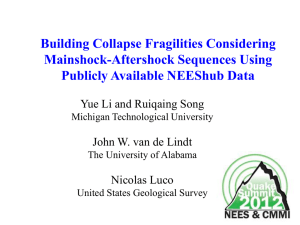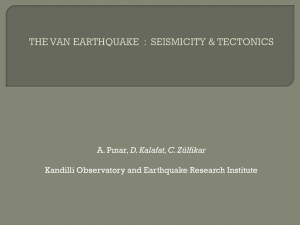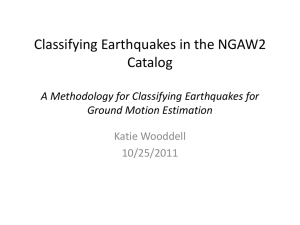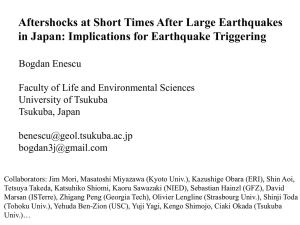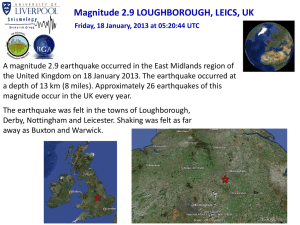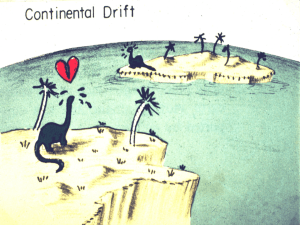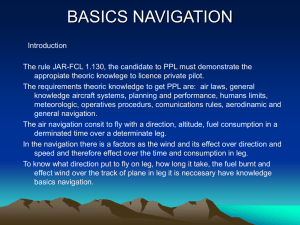Earthquake triggering, foreshocks and aftershocks
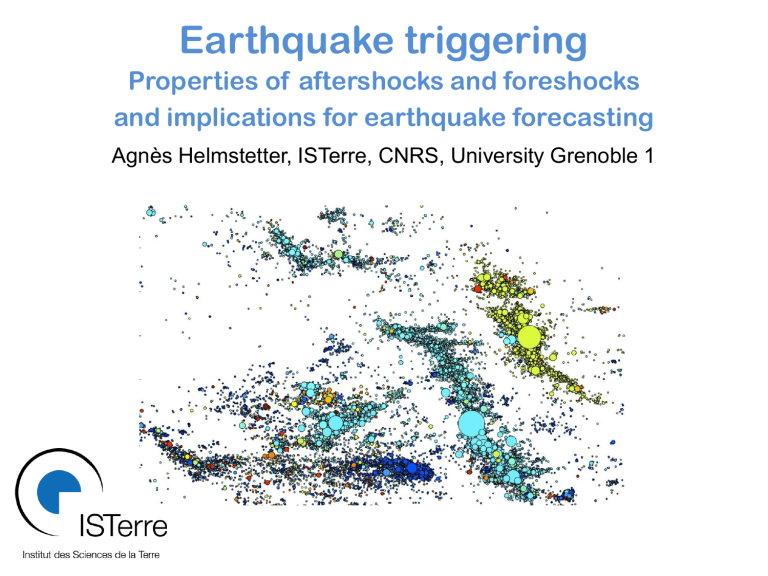
Earthquake triggering
Properties of aftershocks and foreshocks and implications for earthquake forecasting
Agnès Helmstetter, ISTerre, CNRS, University Grenoble 1
Earthquake triggering
When? Where? What size?
Scaling with mainshock size?
How ?…
Outline
Aftershocks when? where? scaling with mainshock size?
why? : static, dynamic, or postseismic stress change?
model? : ETAS or rate & state
Foreshocks
Earthquakes that trigger by chance a larger event
… or part of the nucleation process?
Distribution in time, space and magnitude and comparison with ETAS
Foreshocks and aftershocks of Landers, California
1yr 1 day
M=7.3
M=6.5
1992/4/23
Joshua-Tree m6.1
1992/6/28
Landers m7.3
Foreshocks a few hrs before
Landers m≤3.6
Temporal decay of aftershocks m=7
Japan M=9.1
Sumatra M=9.0
m=2
Omori p=0.9
> stacks for California and rate following the Sumatra and Tohoku M=9 EQs
> aftershock rate ~1/t p with p≈0.9 (Omori’s law)
> duration ≈ yrs indep of M
Scaling with mainshock magnitude
Japan M=9.1
Sumatra M=9.0
N(M)~10 M
California
2<M<7.5
> Aftershock rate N(M)~10 M ~ rupture area
> Magnitude distribution P(M)~10 -M (GR law)
> Small and large EQs have the same influence on EQ triggering !
Aftershocks : Where?
- aftershocks
1 day after
7<m<7.5
-- background
1 day before > relocated catalog for
Southern California
[Shearer et al., 2004]
> average distance
≈ rupture length L
<d> ≈ 0.01x10
m/2 km
> max distance ‘+’ d max
≈ 7 L
≈ 0.07x10
m/2 km
2<m<2.5
distance from mainshock hypocenter (km)
Aftershocks : What size?
> aftershocks magnitude distribution = GR law
> aftershock size does not depend on the mainshock magnitude !
mainshocks 7<m<7.5
b=1 mainshock 2<m<2.5
Dynamic triggering
Seismicity remotely triggered by M7.3 Landers EQ [Hill et al 1993]
Long Valley
Geysers unfiltered filtered 5-30 Hz
Parkfield
> Mostly in geothermal or volcanic areas
>
Dynamic stress change ≈ 1 bar >> static
> During seismic wave propagation but also in the following days
> Transient deformation at Long-Valley : change in fluid pressure ?
Summary of observations about aftershocks
> aftershock rate decays as N~1/t , for t between a few sec and several yrs, independently of M
> + short-term remote dynamic triggering by seismic waves
> number of aftershocks increases as N ~10 M ~ L 2 , for 0< M <9.
> small EQs collectively as important as larger ones for triggering
> the size of a triggered EQ is not constrained by M
> typical triggering distance ≈ L ≈ 0.01x10
m/2 km, max distance for t<1day ≈ 7L
Triggered seismicity : not only aftershocks!
Other evidences of triggered seismicity, natural and human-induced
> rainfall (pore pressure changes due to diffusing rain water)
[Hainzl et al 2006]
>
CO 2 degassing
[Chiodini et al 2004; Cappa et al 2009]
> slow slip events
[Segall et al 2006; Lohman & McGuire 2007, Ozawa et al 2007]
> tides ( hydrothermal, volcanic areas or shallow thrust EQs, ∆ ≈10 kPa, ∆R=10%)
[ Tolstoy et
al 2002 ; Cochran et al 2004]
> migration of underground water or magma
[Hainzl & Fisher 2002]
> nuclear explosions
[Parsons & Velasco 2009]
> mining (stress concentrations due to the excavation)
[McGarr et al., 1975]
> dams ( filling of water reservoirs)
[Simpson et al 1988, Gupta 2002]
> fluid injections or extraction (geothermal power plants, hydraulic fracturing , for oil and gas production, injection of wastewater, extraction of groundwater )
[McGarr et al., 2002;
Gonzales et al 2012; Ellsworth 2013]
… any process that modifies the stress or the pore pressure
What triggers aftershocks?
seismicity rate after a mainshock
R
≈yrs time
Aftershocks triggered by
Static stress changes? postseismic?
Coseismic, permanent afterslip, fluids
σ
σ
≈yrs time time dynamic?
seismic waves
σ
≈sec time
Mechanisms of aftershock triggering
Static stress change permanent change ⇒ easy to explain long-time triggering fast decay with distance ~ 1/r 3 ⇒ how to explain distant aftershocks?
Dynamic stress change short duration ⇒ how to explain long time triggering? slower decay with distance ~ 1/r ⇒ better explains distant aftershocks
Postseismic relaxation afterslip, fluid flow, viscoelastic relaxation slow decay with time, ~ seismicity rate ⇒ easy to explain Omori law but smaller amplitude than coseismic stress change
Modelling triggered seismicity
Statistical model : ETAS seismicity rate = background + triggered seismicity [Kagan , 1981, Ogata 1988…]
R(t,r) = µ(r) + ∑ ti<t ϕ(t-t i
, |r-r i
|, m i
)
Physical model : coulomb stress change calculations + rate & state model
A ≈ 0.01 parameter of R&S friction law, increase of friction with V
σ : normal stress ; τ: coulomb stress change ;τ r
’ tectonic stressing rate r : background seismicity rate for τ ’= τ r
’
; N : cumulated number ∫R(t)dt
[Dieterich 1994]
ETAS model
Input : proba that an EQ (t,r,m) triggers another EQ (t’,r’,m’) time
Results : multiple interaction between EQs time
ETAS : aftershocks and foreshocks (t)
Assumptions:
R(t)
Aftershocks
« direct » Omori law
R d
(t) ~1/t p
Results mainshock
< R(t) >
Foreshocks
Inverse Omori law
R(t) ~ 1 / t p f p f
<p t
Aftershocks + aft. of aft. + …
« global » Omori law
R g
(t) » R d
(t)
R g
(t) ≈ 1/t p g wth p g
<p mainshock t
“Foreshocks”, “mainshocks”, “aftershocks” seismicity rate
Foreshocks inverse Omori law
N(t)~1/(t+c) pf with p f
≤ p
Aftershocks, Omori law
N(t)~1/(t+c) p background rate mainshock
average over many sequences
---- a typical sequence time
ETAS model : main results
Aftershocks
>
“Global” Omori law with a p global
≤ p direct
>
Bath’s law : largest aftershock average magnitude = M-1.2
> Diffusion of aftershocks
Foreshocks
> Inverse Omori law with p foreshocks
≤ p direct
> Rate of foreshocks independent of mainshock magnitude (if any EQ is a mainshock)
> Deviation from GR law b foreshocks
≤ b
> Migration toward mainshock
Rate-and-state : periodic stress changes
> stress : τ(t) = cos(2πt/T) + τ’ r t
> T « t a or T»t a
> t a
: nucleation time ≈ yrs
τ
(t)
R (t)
T» t a slow short-times regime for T « t a
R~R
0 exp( τ /A σ ) tides, seismic waves long-times regime for T » t a
R~d τ /dt tectonic loading
R (t) T «t a fast
Rate-and-state : triggering by a stress step triggering quiescence
> Reproduces Omori law with p=1for a positive stress change
> Requires a very large ∆
: c=10 -4 t a
=100 days A σ =1 MPa ⇒ ∆
=15 MPa !
Heterogeneity of EQ source and aftershocks
Planar fault with uniform stress drop slip ∆
EQ rate
Real faults : heterogeneous slip and rough faults
> hetergoneous stress change in the rupture zone
> most aftershocks on or very close to the rupture zone slip ∆
EQ rate
[Marsan, 2006; Helmstetter & Shaw, 2006]
Slip and shear stress heterogeneity, aftershocks
Modified « k 2 » slip model: U(k) ~ 1/(k+1/L) 2.3 [Herrero & Bernard, 1994] slip shear stress stress drop τ
0
=3 MPa aftershock map synthetic catalog
R&S model mean stress τ
0
R&S model, stress heterogeneity, and aftershock decay with time heterogeneous ∆ Aftershock rate
∆ /As=
10
∆ /As
=-10
Heterogeneous
x(km)
> triggering at short-time t «t a
: Omori law with p<1
> quiescence at long time ( t≈t a
≈yrs)
[Marsan, 2006; Helmstetter and Shaw, 2006]
Modified k 2 slip model, off-fault stress change
• fast attenuation of high frequency τ perturbations with distance d
L coseismic shear stress change (MPa)
Modified k 2 slip model, off-fault aftershocks
• seismicity rate and stress change as a function of d/L
• quiescence for d >0.1L
d
L standard deviation average stress change
R&S and aftershock time decay
> stacked A.S. for 82 M.S. with 3< M <5 z <50 km in Japan
> triggering following Omori law decay for 10 s < t <1 yr with p increasing slightly with time
[Peng et al 2007]
Data
Fit by rate-state model with a
Gaussian stress pdf
<∆ τ > =0 std( ∆ τ )/A s n
= 11 t a
= 0.9 yrs p=1 t a
Modeling aftershock rate with R&S model and heterogeneous static stress change
Sequence
Morgan Hill M=6.2, 1984
Parkfield M=6.0, 2004
Stack, 3<M<5, Japan *
San Simeon M=6.5 2003
Landers M=7.3, 1992
Northridge M=6.7, 1994
Hector Mine M=7.1, 1999
0.68
p
6.2
0.88
0.89
12.
0.93
18.
1.08
**
1.09
**
1.16
**
Superstition-Hills, M=6.6,1987 1.30 **
τ* (MPa)
**
78.
11.
1.1
348.
52.
94.
80.
t a
(yrs)
10.
* [Peng et al., 2007]
** we can’t estimate τ* because p >1
R&S : triggering by afterslip
Mainshock ⇒ coseismic stress change
⇒ afterslip
⇒ postseismic reloading
⇒ aftershocks?
Afterslip Postseismic stress change
V (t) τ (t) time time
Aftershock rate
R(t) time
R&S : triggering by afterslip
We assume stressing rate due to afterslip d τ/dt ~ τ’
0
/(1+t/t * ) q with q =1.3
seismicity rate stressing rate
> Apparent Omori exponent p(t) decreases from 1.3 to 1
R&S model and Omori’s law
Deviations from Omori law with p=1 can be explained by :
Coseismic triggering with heterogeneous stress step
τ(t)
τ(x,y) r
>
> log t short-time triggering p
≤1, p ↘ with t and with stress heterogeneity long-time quiescence
Postseismic triggering by afterslip
τ(t
) r log t
> Omori law decay with p< or >1
EQ triggering and EQ forecasting
> seismicity rate increases a lot (≈10 4 ) after a large EQ
… but the proba of another large EQ is still very low !
> limited use for EQ forecasting ?
>
Methods : statistical (ETAS, STEP, kernel smoothing …) or physical models (R&S +
Coulomb stress change)
> ETAS generally provides the best forecasts
[Woessner et al 2011; Segou et al 2013]
Very simple to use (requires only t,x,y,z,m)
Bad modeling of early A.S. spatial distribution
… but can be corrected (kernel smoothing of early A.S.
) [Helmstetter et al 2006]
> Coulomb-stress change with R&S
Good fit in the farfield, but bad near the rupture (∆ is not accurate)
… but can be corrected by assuming a pdf of ∆
[Hainzl et al 2009]
Usually include only M>6 M.S. (with known slip)
And before the mainshock?
> Increase of seismic activity before mainshock
… on average
> Part of the nucleation process ?
> Or cascading triggering process ?
Seismicity rate before mainshock
Example : seismicity rate before each M>7 mainshock in California and stack for all
M>5 (for R<20 km)
Seismicity rate before a mainshock
> Stacks for California and ETAS for mainshock with 2<M<7.5
> Mainshock : any EQ not preceded by a larger EQ for T=100 days and r<10 km
> Foreshocks : EQs within 100 days before and 10 km
> Power-law ↗ of seismicity : inverse Omori law
> Number of foreshocks ↗ with M because of mainshock selection rules
California ETAS p=0.8
p=0.8
Magnitude pdf of foreshocks
> Stacks for California and ETAS for mainshock with 2<M<7.5
> For small mainshocks : roll-off M foreshock
<M mainshock
> For large mainshocks : increase in the rate of large EQs
> ETAS theory : P(m)= GR(m,b) + GR(m,bα)
[Helmstetter et al 2003]
California ETAS
Spatial distribution of foreshocks (M)
> Stacks for California and ETAS for mainshocks with 2<M<7.5 (SHLK catalog)
California ETAS
> small d : similar pdf(d) for all M, but ! location error ↗ with M
> large d : increase in pdf(d) for all M due to selection rule M
F.S.
< M
M.S.
Spatial distribution of foreshocks (time)
> Stacks for California and ETAS for mainshocks with M>4
California ETAS time before
M.S.
(day)
.
> apparent migration toward mainshock
.
Foreshocks = asesimic loading ?
> Swarms sometimes detected before mainshocks (not explained by ETAS) ex :
M=9 Tohoku [Marsan et al, 2013]
>
«Repeating» EQs (triggered by aseimic slip?) and low-frequency noise ex : m=7.6 Izmit [Bouchon et al 2011] or M=9 Tohoku [Kato et al 2012]
> Slow slip event
Ex : M=8.1 Iquique [Ruiz et al, 2014]
> Accelerating foreshock sequences followed by enhanced aftershock rate
Stack of M>6.5 mainshocks worldwide
[Marsan et al 2014]
> Foreshock / aftershock ratio is too large
Stack for 2.5<M<5.5 mainshocks in California
[Shearer 2012]
> Foreshocks do not promote the mainshock (∆
<0)
Landers M=7.3 and other EQs in California M4.7-6.4 [Dodge et al 1995,1996]
>
Accelerating slip predicted by R&S friction law and lab friction experiments … but very small slip (≈ D c
) and difficult to detect [ Dieterich 1992 ]
Asesimic loading before mainshocks?
> but in most cases nothing special occurs before mainshocks
> and most slow EQs, repeating EQs or swarms are not followed by mainshocks !
> need to consider whole seismicity (not only before mainshocks) to check that these patterns are really unusual !
Swarms before mainshocks
> fitting seismicity with ETAS with variable background µ(t,r) to detect deviations = transient [Marsan et al, 2013]
Transient before
Tohoku, Jan-Feb/2011
≈30 days, 40 km
● all EQs
● transient
> but several other swarms detected not related to large EQs …
Repeating EQs before mainshocks
> accelerating repeating EQs with very similar waveforms during the last 44 mn before
M=7.6 1999 Izmit EQ [Bouchon et al 2011]
> 18 events with 0.3<M<2.7, distant by <20 m
Normalized waveforms, chronological order Waveforms of the 1 st and 2nd ev.
Top : filter <3 Hz
Repeating EQs before mainshocks
> migrating foreshocks and repeating EQs before M9.0 Tohoku [Kato et al 2012]
> repeating EQs : large correlation -> same exact location?
Slow slip events before mainshocks
Intense foreshock activity and a SSE before M=8.1 Iquique [Ruiz et al 2014]
M8.1
M6.7
SSE with slip≈1m following the largest M6.7 foreshock 15 days before mainshock
(or unusually large afterslip?)
Foreshock activity related to enhanced aftershocks
Stacked seismicity rate with M>4 before and after M>6.5 mainshocks in the worldwide
ANSS catalog [Marsan et al 2014]
Population A :
Significant precursory acceleration
Population B :
No significant precursory acceleration
This pattern cannot be explained by ETAS, incompleteness, or # in M.S. M
> episodic creep that preceded the M.S. and lasted during the A.S. sequence?
Foreshocks did not trigger each other and did not trigger the mainshock?
M7.3 mainshock
Stress change due to the Landers foreshocks did not trigger the mainshock (∆ <0)… but results depend on relocation method
M7.3 mainshock
M3.6 foreshock
M3.6 foreshock
[Marsan 2014]
SHLK catalog
M3.6 foreshock
In SHLK catalog
[Dodge et al 1995]
Conclusion
> earthquake triggering explains most properties of EQ catalogs
> triggering mechanism : static? dynamic? postseismic?
> but some discrepancies : swarms, heterogeneity, excess of foreshocks …
> need to model accurately «normal» seismicity to detect deviations
> deviations from normal seismicity ⇒ aseismic loading?
> detection of “aseismic loading” : from EQ catalogs? Geodesy?
> aseismic loading = precursor (part of nucleation)?
> or aseismic loading = potential triggering factor (like foreshocks)?
> implication for EQ forecasting :
↗ in seismicity rate ⇒ ↗ in the proba of a future large event?
Or can we do better?
Tutorial : statistical analyses of EQ catalogs to reveal nucleation and triggering patterns
> distribution of aftershocks and foreshocks in time, space and magnitude
> transient increase in catalog incompleteness after a large EQ, implication for the temporal decay of aftershocks
> how to identify foreshocks, mainshock and aftershocks?
> comparison of foreshocks and aftershocks properties in ETAS model or in the
R&S model
> can we estimate ETAS model parameters (p, c, α, µ, b …) from stacked aftershock sequences?
> how dependent are the results on : parameter choices (windows in time, space, magnitude …), location errors, catalog incompleteness …?
Tutorial
> download and unzip ftp://ist-ftp.ujf-grenoble.fr/users/helmstea/CARGESE.zip
Archive with EQ catalogs, matlab codes, ETAS program
You also need matlab and a fortran compiler to use the ETAS simulator
Tutorial : earthquake catalogs
> ANSS catalog for California
M≥1 ; 31 ≦ lat ≦ 43 °N ; -127 ≦ lon ≦ -110 °
> Relocated SHLK catalog for California
M≥0 ; 31.4 ≦ lat ≦ 37 °N ; -121.5
≦ lon ≦ -114 °
> Worldwide ANSS catalog
M≥4
> ETAS catalog :
GR law : b=1, M
0
=0, m d
=2
Aftershock : productivity K(m)~10
αm with
α=1
Omori law : p=1.1, c=0.001 day
Aftershock spatial distribution : Φ(r,M)~1/(r+d
0
10 M/2 )
1+µ with d
0
=0.01 km and µ=1
Uniform background, R=1000 km, Z max
=50 km, 2 M≥2 EQs / day
Tutorial : codes demo.m :
> plots of earthquakes in space and time to illustrate clustering
> aftershock rate following a large EQ and fit by Omori's law using MLE
> transient changes in completeness magnitude m c after large Eqs
> estimation of m c for different time and space windows (by fitting the mag pdf by the product of a GR law and an erf function) stack_aft.m
> stack of aftershocks sequences for different classes of mainshock magnitude
> simple selection rules (time, space and magnitude windows, following [Helmstetter et al 2005]
> aftershock rate as a function of time, distance and magnitude including correction for time-dependent completeness
> scaling of aftershock productivity with mainshock magnitude
> comparison of California or worlwide seismicity and an ETAS catalog
Tutorial : codes stack_for.m :
> stack of foreshock sequences for different classes of mainshock magnitude
> foreshock rate as a function of time, distance and magnitude
> comparison of California or worldwide seismicity and an ETAS catalog aft_RS
> aftershock rate due to a static stress change using the rate-and-state model, as a function of time and space
[Dieterich 1994]
Tutorial : codes
Toolbox :
> omori_synt_cat : generates a EQ times following Omori’s law
> Omori_fit : fit aftershock time decay by Omori’ law using Max. Likelihood
> get_pm_erfGR : estimation of mc and b by fitting a magnitude distribution by the product of a GR law and an erf function
> get_for, get_aft : selection of F.S., M.S. and A.S. using windows in t, r, and m.
Computes rates of EQs in t, r and m.
> get_mc : compute completeness magnitude for each EQ due to increase in etection threshold following large EQs
[Helmstetter et al 2006]
R&S : triggering by a stress step
Stress change for a dislocation of length L: τ(r)~ (1-(L/r) 3 ) -1/2 -1
R(r) for t<t a
L r
τ
L
R(r) for t>t a
>
>
>
Very few events for r>2L
«diffusion» of aftershocks with time
Shape of R(r) depends on time, very # from τ (r)
> Difficult to guess triggering mechanisms from the decrease of R(r) r
